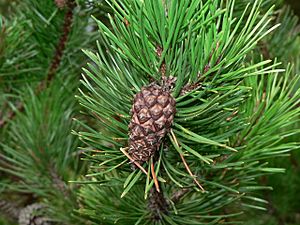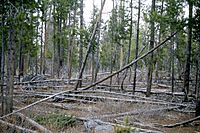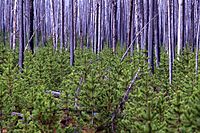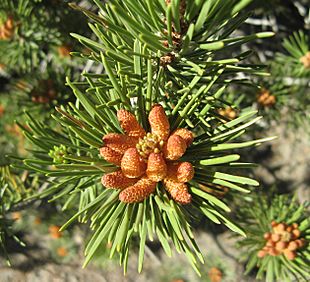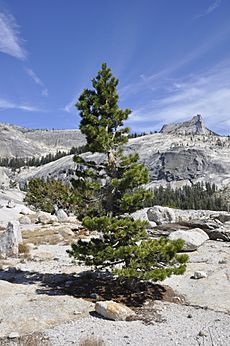Lodgepole pine facts for kids
Quick facts for kids Lodgepole pine |
|
|---|---|
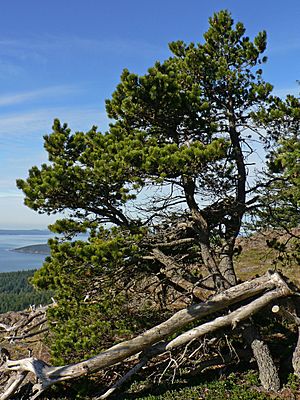 |
|
| Pinus contorta subsp. contorta in Anacortes Community Forest Lands, Washington | |
| Conservation status | |
| Scientific classification | |
| Genus: |
Pinus
|
| Species: |
contorta
|
| Subspecies | |
|
4, see text |
|
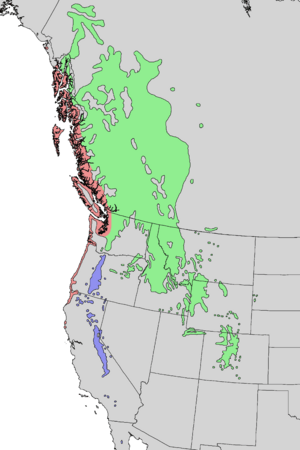 |
|
Distribution map:
|
|
The Pinus contorta, often called the lodgepole pine or shore pine, is a common tree. You can find it in western North America. It grows well near the ocean and in dry mountain forests. It is also found in very high, cold areas. Like all pine trees, it is an evergreen conifer. This means it keeps its needles all year long.
Contents
Types of Lodgepole Pine
There are four main types, or subspecies, of Pinus contorta. Each one has slightly different features. Sometimes, these types are called varieties instead of subspecies.
| Cone | Image | Subspecies Name | Common Name & Where It Grows |
|---|---|---|---|
 |
 |
Pinus contorta subsp. bolanderi | Bolander's beach pine. This type grows only in Mendocino County on the California coast. It is almost threatened due to fires and building. |
 |
 |
Pinus contorta subsp. contorta | Shore pine. You can find this type along the Pacific Coast. It grows from southern Alaska down to northwest California. |
 |
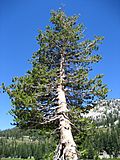 |
Pinus contorta subsp. murrayana | Tamarack pine or Sierra lodgepole pine. This type grows in the Cascade Range and the Sierra Nevada mountains. It is found from Washington down to northern Baja California. |
 |
 |
Pinus contorta subsp. latifolia | Lodgepole pine. This type is common in the Rocky Mountains. It grows from Colorado up to Yukon and Saskatchewan. |
What Lodgepole Pines Look Like
The Pinus contorta can be a small shrub or a tall tree. The shrub form is usually short, about 1 to 3 meters (3 to 10 feet) tall. The tree form can grow very tall, up to 40 to 50 meters (130 to 160 feet) high. Its trunk can be as wide as 2 meters (6.5 feet). The murrayana subspecies is the tallest of them all.
The top of the tree, called the crown, is usually rounded. In thick forests, the crown is slim and shaped like a cone. The branches are strong and flexible.
The name contorta means "twisted." This name comes from the twisted shapes of the pines found near the coast. It also refers to the tree's twisted needles. Other names for this tree include black pine, scrub pine, and coast pine. The latifolia subspecies can mix with the jack pine (Pinus banksiana).
Needles and Buds
The tree's new growth buds are reddish-brown and about 2 to 3 centimeters (0.8 to 1.2 inches) long. They are a bit pointy and sticky. New growth starts in early April and finishes by early July.
The dark, shiny needles are pointed. They are about 4 to 8 centimeters (1.5 to 3 inches) long. The needles grow in pairs on short stems. They usually stay on the tree for four to six years. Some can even last up to 13 years!
Cones
The cones of the lodgepole pine are about 3 to 7 centimeters (1 to 3 inches) long. They have small, sharp points on their scales.
Many lodgepole pines in the Rocky Mountains (the latifolia subspecies) have special cones. These cones are called serotinous cones. This means they stay closed until they get very hot, like during a wildfire. The heat from the fire makes them open and release their seeds. This helps new trees grow after a fire. The cones of the coastal types usually open on their own without fire.
How Lodgepole Pines Live (Ecology)
The lodgepole pine needs wildfires to stay healthy. Its bark is thin, so it doesn't protect the tree much from fire. However, the fire's heat helps its cones open and release seeds. This allows new lodgepole pines to grow and keep their place in the forest.
If there are too many efforts to stop all wildfires, it can actually harm the forest. The trees grow very close together. When some trees die, they stand tall and dry. These dead trees can act like a ladder, helping fire climb up to the living tree tops. Once a fire reaches the tree tops, it can spread very fast and become hard to stop.
Wildfires in these forests often happen after years of dry weather. Lodgepole pines grow in high places where they get a lot of snow in winter. The dense trees also prevent smaller plants from growing on the forest floor. Because of this, small ground fires are rare. Instead, big, strong fires happen less often but cause a lot of change.
The weather plays a big role in these fires. Things like the Pacific decadal oscillation (PDO) and El Niño (ENSO) affect how much water these forests get. When certain weather patterns combine, they can cause droughts. These droughts then increase the chance of severe fires in the high mountain forests.
A special fungus called Suillus tomentosus helps lodgepole pines. This fungus grows with the tree's roots. It helps the tree get nitrogen from the soil. Nitrogen is a nutrient that helps trees grow. This allows the pines to grow in places where the soil doesn't have many nutrients.
Threats to Lodgepole Pines
Lodgepole pines can be attacked by a fungus called Grosmannia clavigera. This fungus is spread by the mountain pine beetle. The beetle carries the fungus in its mouth.
Scientists have also found that climate change could cause problems for lodgepole pines. By the end of the 21st century, these trees might not be able to grow in as many places as they do now.
How People Use Lodgepole Pines
Building and Wood
Lodgepole pines are grown in special tree plantations in places like Norway, Sweden, and the United Kingdom. Their wood is used for building and timber. In North America, it's also used for lumber that is treated to last longer.
The name "lodgepole pine" comes from how Native Americans used these trees. They used the tall, straight trunks to build their lodges, also known as tepees.
Traditional Medicine
Native peoples of the Pacific Northwest and California used different parts of the lodgepole pine. They used it as a traditional medicine to help with various health problems.
Growing Lodgepole Pines
The lodgepole pine is also grown as an ornamental tree for gardens. Plant nurseries grow different types of lodgepole pines. They are used in regular gardens, wildlife gardens, and for natural landscaping. The smaller types of Shore pine (ssp. contorta) are also used in pots and for bonsai.
Some special types of lodgepole pine grown by people include:
- "Chief Joseph": This is a small type of Pinus contorta var. latifolia. It is grown because its needles turn yellow in winter.
- "Spaan's Dwarf": This is a small type of Pinus contorta var. contorta. It grows wider than it grows tall.
The "Chief Joseph" type has won an award called the Royal Horticultural Society’s Award of Garden Merit.
Official Tree
The lodgepole pine is the official tree of Alberta, Canada.
Invasive Species
In New Zealand, the Pinus contorta is considered a serious invasive species. This means it spreads easily and can harm the local environment. It is not allowed to be sold or grown there.
See also
 In Spanish: Pinus contorta para niños
In Spanish: Pinus contorta para niños



